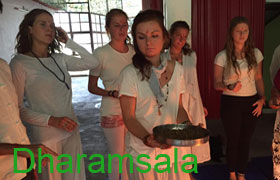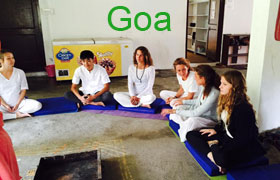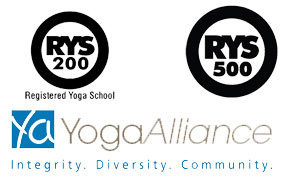Ekapadaskandasana
Procedure
1. Sit down in the posture of danda asana.
2. Hold your left leg with both of your hands and place it over your shoulder with the support of your head and neck.
3. Keep your right leg straight and fold both of your hands in namsakara mudra. Keep your vision straight in front.
4. Pause in this state for a while as long as you can. Then place your left leg down with the help of your hands. Now repeat the process with your right leg too.
Benefits
1. Reduces the unnecessary muscle in shin and thigh areas.
2. Regulates the digestive system and strengthens the hips.
Precautions
This asana should be prohibited in the case of cervical spondylitis.
Vaddh Padmasana
Procedure
1. Sit in the posture of padmasana.
2. Run your right hand behind your back and try to hold the feet of your right leg with it.
3. Similarly run the left hand behind your back and hold the feet of your left leg with it.
4. Keep your body straight and your sight will reside in front.
5. Pause for a while in this posture and then slowly release your hands and legs. Finally relax in dandasana.
Benefits
1. Highly beneficial for back ache and pain in hip.
2. This is one of the meditative postures, thus it improves the concentration.
3. It is very good for shoulders.
Precautions
You should not practice this asana of you have undergone any surgery in shoulders or ankles.
Our yoga teacher training in Goa provides the perfect environment to get trained as a yoga expert.
Brahmacharya Asana
According to Swamy Satyananad Saraswati ji the brahmacharya asana is described as follows. This asana can protect celibacy. Hence it is called brahmacharya asana. This also enables and individual to attain ability and strengthens his hands.
Procedure
1. Sit down in the posture of dandasana and place both of your hands adjacent to your hips.
2. Inhale air into your chest and raise both of your legs along with your hips off the ground.
3. Pause in this position as long as you can and revert to original state.
Precautions
You should not practice this asana if you have any problem in your wrist, elbow or shoulder.
Bhunamanasana
Procedure
1. Sit in the posture of dandasana.
2. Raise both of your hands and keep them parallel to your legs.
3. Turn towards your left and place both of your palms on the floor and bend to try to make your forehead touch the ground.
4. Pause in this position for a while and repeat it on the other side too.
Benefits
1. It is very good for your spinal cord. Apart from stretching the spinal cord, it imparts good influence over the lower part of your back.
2. It is highly beneficial for diabetes and respiratory system. It influences pancreas too.
Ardha Chandrasana
Procedure
1. Sit in the posture of vajrasana.
2. Keep both of your knees apart and kneel down.
3. Hold the right side with your left hand and left side with your right hand
4. Lean backwards while you inhale.
5. Pause for a while in this posture and come forward while exhaling and finally revert to vajrasana.
Benefits
1. It is good for back ache, neck pain, spinal cord, lungs and digestive system.
2. It alleviates the fat from stomach and thighs.
3. Greatly influences pancreas and thymus glands
Precautions
You should not practice this asana if you suffer with hernia or knee pain.
Marjari Asana
Marjari in Sanskrit means a cat. This asana look like a cat thus it is called marjari asana.
Procedure
1. Place both of your palms and knees on the ground and inhale air into your chest and raise your head up and drop your spinal cord and hip downwards.
2. After pausing in this position for a while, raise your spinal cord up and head downwards. Repeat this for 5 to 6 times.
Benefits
1. It relieves you from back ache and strengthens your shoulders, knees and makes your spine flexible. It is good for cervical.
Precautions
This asana should not be practiced if you have pain in your knees.
Siddhasana
Precautions
1. Sit down in the posture of dandasana.
2. Fold your left leg and place it under your hips.
3. Similarly fold your right leg too.
4. Keep your spine straight and keep both your hands on knees in gnyan mudra. You can either close your eyes or keep your sight on the tip of your nose.
Benefits
1. It improves the concentration of your mind and imparts mental peace.
2. Reduces the inclination towards sexuality and opens the door to salvation.
3. It relives you from all kinds of diseases.
Precautions
Sit on a cushion used for back ache and practice this asana.
You should not miss out an opportunity to join our yoga teacher training program in India if you wish to excel in this invaluable art.




